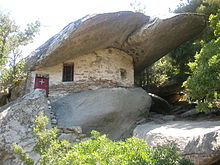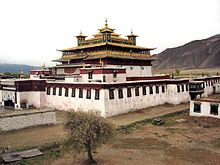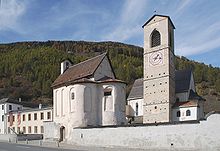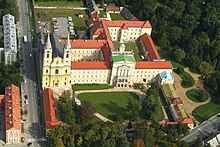monastery

A monastery is a facility in which people ( called monks or nuns in the contemplative order ) live together in a communal way of life focused on the practice of their faith ( Vita communis ) . The monastery complex usually consists of cult, residential and farm buildings and possibly other structures.
In the western cultural area, Christian monasteries in particular are known, most of which belong to the Catholic Church and the Orthodox Churches. There are also Protestant (for example the Amelungsborn Monastery ) and ecumenical (such as the Taizé ) monastic communities. In addition, monasteries of Asian religions, in particular the residential complexes of Buddhist monks and the prayer and meditation centers of Hindu communities, are also referred to as monasteries.
Christian tradition
Basic concepts
The name monastery comes from the Latin : claustrum, which means “closed place” (see also: enclosure ). Later, claustrum was used in particular to describe the inner courtyard of a monastery, which is typical of Western monastery architecture and is called " cloister " in German . In English (cloister), French (cloître), Italian (chiostro), Spanish (claustro) and in other languages, the Latin root lives on in this specific meaning to this day. In German, Dutch (klooster), Hungarian (kolostor), Estonian (klooster), Polish (klasztor), Czech (klášter) and in the Scandinavian languages (kloster) , however, the designation was generalized and describes the monastery structure as a whole or the monastery as a facility in itself.
The monastic way of life of Christian monks and nuns is called monastic , which is derived from the Greek word for " monk " (μοναχός, monachós) . From the derived μοναστήριον (monastḗrion, Latin monasterium) come the names corresponding to the German term "monastery" in many other languages: monastery (English), Монастырь (Russian), monastère (French), monasterio (Spanish). This root has also been preserved in German in the word Münster (ahd. Munistri, munsri) .
As the Convention usually the entire community or community designated, who lives in a monastery especially in the mendicant orders . This term is also sometimes used for the living area of the monastery itself. In a narrower sense, convention refers to the assembly of the conventuals, the voting members of the community. Monasteries that are regularly headed by an abbot are called abbeys . Further terms for branches of different orders are priory , residence, hospice , house, community or fraternity . A special feature is the name Carmel for a monastery of the Carmelites or Carmelites after the Carmel Mountains in Israel.
construction

The ideal-typical structural floor plan of an early medieval monastery can be read from the St. Gallen monastery plan . The monastery church usually forms the spatial and spiritual center of a monastery complex. The cloister courtyard is the mostly square central area of a cloister, surrounded by a cloister , around which the cloister church, refectory (dining room), dormitory (bedrooms) and chapter house (assembly room), sometimes an infirmarium (sick ward) and the necessarium (need room ) are grouped. Depending on the orientation of the monastery, there was also a writing room ( scriptorium ) and usually a library . In addition, a number of auxiliary and farm buildings often belong to the monastery complex, for example for agriculture and, for the Cistercians, for fish farming. For priest monks and lay monks (conversations) there were separate rooms in many abbeys with their own refectories, dormitories and infirmaries.
With the mendicant orders , the space allocation was simpler. The monasteries and churches were located in the cities and not, as was usually the case with Benedictines and Cistercians, in the countryside, which resulted in a cramped inner-city structure. In the Middle Ages, however, the type of monastery buildings that were grouped around an inner courtyard and directly connected to the church of the mendicant order predominated.
Monastery life
For classical monasteries, the monastic (monastic) way of life is decisive. It is characterized by collective and individual prayer , contemplation, silence, contemplation and isolation from the world, physical work, spiritual and spiritual study and hospitality . For monastic orders, the lifelong bond of the monk or nun to the monastery into which he or she has entered is also typical. With other orders, such as the mendicant orders, the possibility of a transfer from one monastery to another is common.
In the west, a monastery is usually assigned to a religious order whose rule determines life in the monastery. Monastic orders that live in cloistered form in monasteries are, for example, Benedictines , Cistercians , Trappists , Carthusians as well as the Carmelites and the Poor Clares . Religious who also, but not exclusively, live in monasteries and do not lead a strictly monastic life are, for example, the mendicant orders (e.g. Franciscans , Dominicans and Carmelites ) or the Canon Regulars (e.g. Premonstratensians ).
In the Eastern tradition, monasteries are far more independent than in the Western Church. They are either completely autonomous or in loose associations, but not, as in the Western Church, orders or grouped into monastic congregations . At the same time, monasteries play a very important role in the religious and ecclesiastical life of the Orthodox churches . Almost all of the higher clergy in these churches come from monasticism.
History and cultural significance

The first monasteries emerged from hermit colonies in the 4th century ( Egypt and Palestine ).
The Coptic Antony Monastery ( dedicated to Antony the Great ), built in Egypt from 361 to 363 , is considered to be the oldest Christian monastery in the world. Also very old is the still existing monastery Mor Gabriel in Tur Abdin (Turkey), which was founded in 397 by Shmuel (Samuel) and his disciple Shem'un (Simon). This means that the monks and nuns are continuing a tradition that has been uninterrupted for 1600 years.
The first western monasteries include the Marmoutier monastery on the Loire, which is said to have been founded by St. Martin of Tours , as well as the St. Maximin Abbey in Trier on German soil . The Abbey of Saint-Maurice , the 515 of King Sigismund was built, is the oldest existing without interruption monastery in Western Europe. Benedict of Nursia founded the prototype of the western monastery, so to speak, in Montecassino in 529 and put together a rule for coexistence in the monastery , the Regula Benedicti , which shaped the development of the monasteries over many centuries. The Benedictine monasticism based on it is the formative monastic trend of Western Christianity to this day. The Orthodox and Oriental monasteries of the Eastern tradition, however, mostly follow the monastic rule of Basil of Caesarea or that of Theodor Studites .
From the beginning, the monasteries were not only places of spiritual life, but also centers of craft and agricultural arts as well as research and the collection of knowledge ( monastery library ). They played an important role in the preservation or re-acquisition of knowledge that had been lost since antiquity and its dissemination. Particularly noteworthy here is the vivarium founded by Cassiodor around 554 in southern Italy .


In the Middle Ages , monasteries were important for the development of Western culture and centers of education. Cultural work took place almost exclusively in monasteries. Monks copied old books, produced works of art and cultural goods such as the regalia of the Holy Roman Empire and ran monastery schools for their children. For a long time, basic cultural techniques such as reading and writing were practically only widespread in monasteries. They also ran their own handicraft and agricultural businesses and developed practical techniques in agriculture , plant breeding or herbs and medicine ( monastery garden ), which they sometimes passed on to the population. The monasteries thus functioned as bases for missionary work and cultivation and became important development centers. Prudent rulers recognized this. They often founded monasteries in underdeveloped areas and provided them with large estates. The name pen , which reminds of the foundation by a secular gentleman, emerged from this. A typical colonization order were the Cistercians , who cleared extensive forest areas, especially in the north and east of Europe, and prepared them for settlement by settlers.
Time and again, monastic reform movements were directed against an excessive secularization of the monasteries. For example, the Cluniac Reform , which originated in the Cluny Abbey , or the Reform Order of the Cistercians should be mentioned here . In general, the history of the monasteries can be read as a constant alternation between “secularization” and reform in the sense of a return to the rules. The reason for the ever-present danger of grievances in the monasteries was in particular the fact that entry into a monastery did not always take place for religious reasons and voluntarily, but also secular motives such as gaining political power and exerting influence (e.g. from noble families in the Middle Ages), economic ones and social security and care (e.g. children not entitled to inheritance who had no economic basis for starting their own family) or prestige and career goals played a role. The inadequate personal identification of individual or entire groups of community members with the religious and ascetic goals of monastery life could gradually lead to the decline of the customs of the entire monastery, especially since leaving the monastery was usually only possible by fleeing. So came u. a. several popes in monastic custody . In the Middle Ages, however, it was precisely the reform-oriented monasteries and monastery associations, strictly committed to monastic ideals, that gained great economic and political influence, which from today's point of view may appear to be a form of “secularization”, but according to the worldview of the time, it was generally rated positively.
With the growing influence of the cities, the importance of the classical, monastic monasteries declined. Their role as centers of culture and development was now taken over by the cities with their craftsmen , schools and universities . With the rise of the hospital and mendicant orders ( Franciscans , Dominicans , Carmelites , Augustinians , Antonites ), the new type of city monastery was created, in which a completely different type of religious life was established, which no longer pursued classical monastic ideals. These monasteries were not located in remote areas in difficult-to-access areas, but in the middle of the emerging cities. Practically all major city foundations received at least one monastery within the city walls . The friars were no longer tied to the monastery like monks, but could be transferred within their order or set out on a journey. They did not lead a purely contemplative life, but worked in church service among the people and were primarily devoted to pastoral care , sermons and other church tasks.
This new form of religious life was only open to women to a very limited extent until the 19th century due to the social restrictions at the time. For this reason, among other things, nuns generally led a strictly cloistered , contemplative life in later times , even if their monasteries were in the city and regardless of whether they were in the tradition of the old monastic monasteries or the mendicant orders (such as the Carmelites or the Poor Clares ) . That changed only slowly with the rise of the female school orders and the charitable sister communities that worked in hospitals, schools or similar institutions. Thus opened up Women's_Orders a new area in the poor relief , the nursing and elderly care .
In the upheavals of the Reformation affected land lines many monasteries were canceled due to lack of demand in the 16th century, as most Protestant reformers the religious life calling upon opposed to standing and religious to leave their monasteries. The effects of war and looting also led to the destruction of monasteries again and again (especially during the Thirty Years' War in Germany), which were not always rebuilt. The biggest turning point was the dissolution of church property through secularization following the French Revolution and the spread of the idea of a secular reason of state in the areas dominated by Napoleon . Through secularization, the monastery property fell either directly to the state or to noble families, and less often to middle-class families. The secularization as a result of the Reichsdeputationshauptschluss (1803) affected around 300 monasteries , monasteries and abbeys in one fell swoop . Some of them were demolished, some used for other purposes or sold. Many monastery churches were converted into parish churches (often under pressure from the faithful) in order to save them from destruction. The monastery libraries, however, were dissolved; their holdings became state property or were incorporated into private libraries. Many books were also lost.

A turning point only came when religious orders were able to buy back secularized monasteries in the second half of the 19th century or, in Catholic countries, got some of them transferred back. Since then, new monasteries have also been built and new religious orders founded. While many monasteries survived National Socialism largely unscathed, monasteries were dissolved again or monasteries were nationalized in communist territories , including in East Germany after 1945. In East Germany, the properties were transferred back after the fall of 1989 . Since then, there have also been new foundations there. Overall, however, the offspring of the monasteries in Western Europe declined sharply in the course of the 20th century due to the generally declining importance of Christianity and piety in modern, pluralistic society.
Islamic tradition
Also of Sufism knows a diverse konventuales cohabitation of brothers that are not linear but comparable with the Western monastic tradition.
See:
Buddhist tradition

In the early days of Buddhism , the life of Buddhist monks was characterized by the fact that, in contrast to the practicing Buddhist laypeople, they were always on the move , just as the founder of the religion Buddha himself led a itinerant life until his death. The Buddhist monasteries were built as a place of residence for the monks during the rainy season .
First of all, the lay faithful donated land so that the monks could build their temporary accommodation on it during the rainy months. Only later were they given permanent accommodation and the living area was finally expanded to include a central hall for meetings. Today a monastery is only considered one if it has a meeting hall and a fully ordained monk presides over it.
Buddhist monasteries are not designed to be self-sufficient . Originally, the Buddhist monasteries did not own any real property, as it later became customary, for example, in Tibetan Buddhism. The monks earned their livelihood solely by collecting alms , not by working or leasing land. The basics of life as a monk in a monastery are laid down in the Patimokkha , which can be compared to a rule of the order .
The main tasks of the Buddhist monasteries today are:
- Place of rest and retreat from worldly life;
- Meeting place for performing rituals ;
- Meeting place for administrative meetings;
- Place of teaching and study;
- Point of contact for victim acts by laypeople;
- Place for the “pastoral” care of laypeople;
- Temporary stay for laypeople, for study and meditation ( retreat ).
Due to the very different focus of tasks, the monastic communities of many monasteries have specialized in individual activities. Among other things, there are:
- Cave monasteries and forest monasteries, which mainly serve as places of retreat;
- Village monasteries, which are open to the population in addition to monastic life;
- School and teaching monasteries, which primarily serve the religious practice and training of monks and lay people.
Buddhist monasteries are consecrated and are then forever monasteries, even if nobody lives in them anymore and only ruins remain; consecrated places can no longer be desecrated. Because giving away the property to the monks is considered a sacrifice, the monks can no longer return, give away or even sell the place - even if they want to - because this would destroy the good work or the merits of the donor. Refusing alms is the only sanction monks can impose on lay people. It is used, for example, in the case of unjustified defamation and defamation of community members.
In Thailand , Myanmar / Burma , Laos and Cambodia , where Theravada Buddhism is practiced, the monasteries are called Wat . In Tibet , many monasteries owned large areas of leased land before the land was annexed by the People's Republic of China .
Zen Buddhism (mainly practiced in China , Vietnam , Japan and Korea ) is the only tradition within Buddhist monasticism in which the monks usually work and the monasteries are partly self-sufficient. The charity course continues here as a sign of humility and to give the laypeople the opportunity for meritorious action.
Hindu tradition
Indian monasteries are called Mathas . There are a number of Hindu orders today .
The basic idea of a monastery to withdraw from the secular world and to get closer to God in isolation can also be found in Hinduism. Already the concept of the four stages of human life (pupil, housekeeper, the loneliness of the forest, seeker of salvation) shows that Hinduism envisages the path of withdrawing from the world. The Hindu way of life expressly provides that man should marry and have children (as Grihastha , housekeeper), but should devote himself to religious studies at a young age (as Brahmacarin , pupil), to which he should in later years (as Vanaprashta and Sannyasin ) can build. The Brahmin priests therefore never abstained in India. However, abstinence for the phases of life that are determined by religious search has always played a major role in Indian thought.
In addition to this Brahmanic model of life, there are countless sadhus , ascetics in Hinduism who wander around and are not tied to an institution such as a monastery. The myths tell of rishis (wise men) who sought knowledge in solitude. Today there are swamis and gurus who often operate an ashram in which they teach meditation and impart religious teachings to the believers. The attachment of a believer to an ashram, however, is a long way from the finality of ordination; In addition, the individual ashrams are independent and not tied to a superordinate institution.
In later times (after 800 AD) the ashrams were joined by the monasteries ( matha ), which were often connected to a temple and which have been centers of spiritual life, learning and religious activity up to the present day. Some monasteries own and maintain temples, schools, hospitals, orphanages etc. The scholar Shankara (788-820 AD) founded an order of monks and many monasteries, also to promote the sense of belonging among the Hindu movements. These monasteries and their rulers ( Mahant ) are still considered to be the highest religious authorities by many Indians, although they have never attained the position of the highest authority in religious matters.
Due to the Islamic influence in North India, large monasteries and temples are now mainly in South India.
See also
Movies
- Monasteries of Europe - witnesses to the invisible. Five-part television documentary by Marie Arnaud, Jacques Debs ( Arte , France 2018)
literature
- Stefan Benz: women's monastery in Central Europe. Directory and description of their historical culture 1550–1800. Aschendorff, Münster 2014, ISBN 978-3-402-11584-8 .
- Christopher Brooke: The great time of the monasteries 1000-1300. Herder, Freiburg im Breisgau 1976, ISBN 3-451-17433-2
- Gudrun Gleba: Monasteries and orders in the Middle Ages. 3rd edition with a revised bibliography, WBG, Darmstadt 2008, ISBN 978-3-534-20002-3 .
- Hiltrud Kier , Marianne Gechter (Ed.): Women monasteries in the Rhineland and Westphalia. Schnell + Steiner, Regensburg 2004, ISBN 978-3-7954-1676-8 (catalog for the exhibition Krone und Schleier with contributions by the editors and by Ria Borgmann, Christel Diesler, Ralf Dorn, Christiane Elster, Ivonne Jerzyk, Susan Marti, Petra Marx , Margit Mersch, Andrea Raffauf-Schäfer, Lena Weber, Janina Wegner-Keres, Roswitha Wissen).
- Patrick Leigh Fermor : Journey into Silence - Visiting monasteries. Fischer TB 17693, Frankfurt am Main 2010, ISBN 978-3-596-17693-9 .
- Gert Melville : The world of the medieval monasteries. History and forms of life. Beck, Munich 2012, ISBN 3-406-63659-4 .
- Steffen Patzold : Conflicts in the monastery. Studies of disputes in monastic communities of the Ottonian-Salic Empire. Husum 2000, ISBN 3-7868-1463-5 .
- Eckart Roloff : Monasteries, the nucleus of progress. With pioneers between tradition and innovation. In: ders .: Divine flashes of inspiration. Pastors and priests as inventors and discoverers. Weinheim, Wiley-VCH 2010, pp. 21–51, ISBN 978-3-527-32578-8 (with illustrations primarily on manuscripts, cartography, beer brewing, bell casting and monastery medicine).
- Thomas Sterba: Herder's new monastery dictionary. Herder, Freiburg im Breisgau 2010, ISBN 978-3-451-30500-9 .
- Wolfgang Urban : Places of Silence . Monasteries in Baden-Württemberg. With pictures by Hans Siwik. Text by Wolfgang Urban. Verlag Katholisches Bibelwerk , Stuttgart 1998, ISBN 3-460-33083-X .
Web links
- Internet portal for monasteries in German-speaking countries
- Monastery in Lower Saxony (map)
- Internet portal of the orders in Germany
- Thuringian monastery book
- "Rete Vitae Religiosae Mediaevalis Studia Conectens"
- Image archive of the House of Bavarian History (see project churches and monasteries)
Individual evidence
- ^ Karl Suso Frank : Convent . In: Walter Kasper (Ed.): Lexicon for Theology and Church . 3. Edition. tape 6 . Herder, Freiburg im Breisgau 1997.
- ↑ Manfred Heim: From indulgence to celibacy: Small encyclopedia of church history. (= Beck'sche Reihe. Volume 1857), CH Beck, Munich 2008, ISBN 978-3-406-57356-9 , p. 251 ( digitized version ).
- ↑ Herder's Lexicon of the Popes, Verlag Herder Freiburg im Breisgau 2010, ISBN 978-3-451-06200-1







